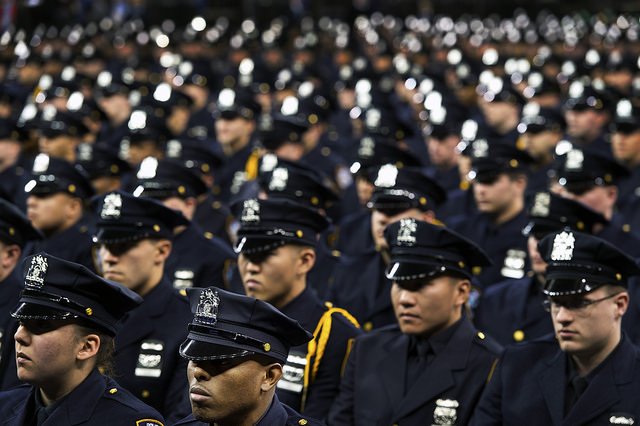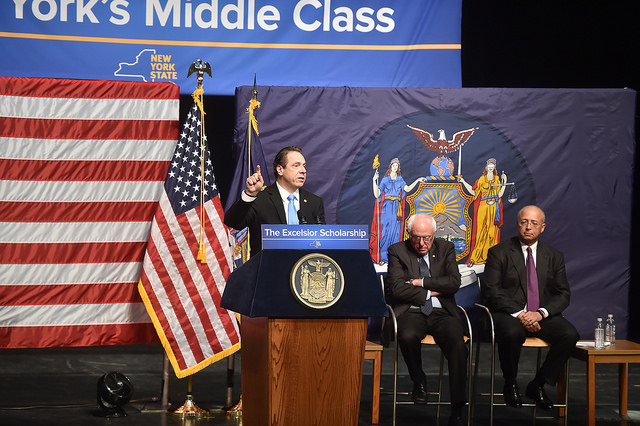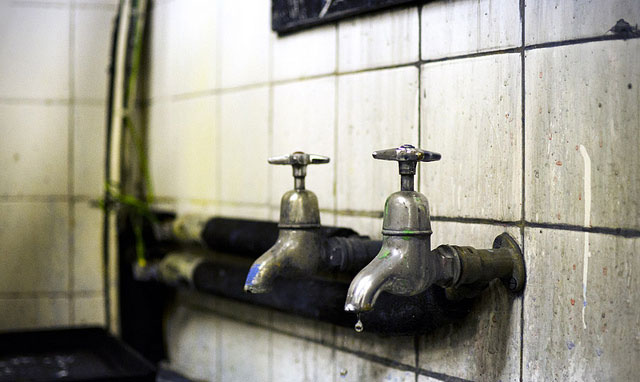Pulling the Public into Police Accountability

(photo: Demetrius Freeman/Mayor's Office)
The NYPD released its new body-worn camera policy last week. For the first time ever, the department relied on public opinion to help guide that policy. With help from the Policing Project, a New York-based organization dedicated to bringing the public voice to policing policy, more than 25,000 New Yorkers and 50 community-based organizations gave their input.
Unfortunately, many of those New Yorkers were disappointed to see that their top recommendations were not accepted by the NYPD. But while we sympathize with the desire to see the NYPD adopt more of the public’s views – and while some of our own preferences diverged from the policy adopted by the NYPD – it’s important to recognize that the NYPD’s policy process was an important step in the right direction and offers significant lessons moving forward.
The public was clear in its views on how the cameras should be used.
For example, members of the public thought officers should not be able to view body camera footage before writing a report on a use-of-force incident. The public also thought a broad array of police interactions should be recorded. And, importantly, the public felt strongly that body camera footage should be more accessible.
The NYPD policy did not accept the public’s recommendations on those key issues.
However, it is important to separate out two issues here: the process and the results. Many New Yorkers may not like the results, but the process offers many guideposts for how to do public input correctly.
In general, we don’t really have a system for public input in policing policy. The only place where we have any form of public accountability in policing today is after something has already gone wrong. There, we have inspectors general and grand juries and civilian review boards. Even body cameras themselves are a form of back-end accountability. This system can help ensure that rules are followed, but it says nothing about what the rules should be in the first place.
The NYPD’s process on body camera protocols proves that democratic engagement on the front end of writing policing rules is both possible and desirable. The NYPD made a number of changes to its policy in response to public opinion, including requiring officers to notify members of the public when they are being recorded, and increasing how long it will retain video, from six months to one year.
Even where it did not follow public opinion, the NYPD responded thoughtfully and in great detail.
The Department should be commended for engaging in this effort. It shows that democratic process around policing is possible, and should become the norm.
But what about the fact that the NYPD ultimately did not follow public opinion on some critical issues? That raises hard questions about what form the public voice in policing should take. Here, there are no easy answers. The very idea of the public having any voice in policing rules is so new that we have no clear models for how to proceed.
Elsewhere in government, we have two very different models for obtaining public input into government decisions. Each gives us something in the way of outcomes.
Decisions made by legislatures tend to be quite responsive to public input. But legislative bodies also can be beholden to special interests, such as police unions. And it can be tough to get legislative bodies to even act in the first place. Look how long it took the City Council to do anything about stop and frisk. And one thing is for sure: legislative bodies never respond to public input in the thorough way the NYPD did here.
On the other hand, administrative agencies are not required to follow public input, even though they are required to obtain it. Their obligation is to make rational decisions, which includes offering reasons—that later, if necessary, can be evaluated by courts—to support the conclusions they come to. Agencies have to open themselves up to public opinion, and respond to it, but they don’t have to follow it. Agencies just have to have a basis for their decisions in fact, even if the public disagrees. Here, the NYPD acted more like an administrative body.
So, which way of incorporating public voice into policing is appropriate? Each system has its advantages and disadvantages. Neither will make everyone happy. For policing we may need a combination.
This process makes clear that it is better to get public input into policing than to have police departments simply do as they choose without consultation.
This process did not make everyone happy. But it was certainly much better than no process at all.
***
Barry Friedman is the Director and Founder of the Policing Project at NYU Law School. Maria Ponomarenko is the Deputy Director. They recently led the writing of Report to the NYPD Summarizing Public Feedback on its Proposed Body-Worn Camera Policy.
***
Have an op-ed idea or submission for Gotham Gazette? Email This email address is being protected from spambots. You need JavaScript enabled to view it.
After the Excelsior Scholarship

Gov. Cuomo (photo: Kevin P. Coughlin/Governor's Office)
Victory for middle class New Yorkers! The state budget finally passed and it includes a number of college affordability reforms for middle class students. Despite some of the shortfalls of these reforms, they are an exciting step forward in reinvesting in the state’s public university systems after years of structural disinvestment, flat financial aid, and tuition hikes.
These reforms must be treated as initial progress toward greater investment into SUNY and CUNY that will truly eliminate cost as a barrier to access and success.
The newly established Excelsior Scholarship will cover the remaining cost of tuition after SUNY or CUNY students have used their Tuition Assistance Program (TAP) and their federal Pell grant awards. Only full-time students who come from families with incomes of less than $125,000, who take 30 credits a year, and who graduate on-time will be eligible by the end of a three-year phase-in.
The budget also established a Part-Time Scholarship (PTS) that is available to community college students based on financial need who take more than six credits but less than 12 credits a semester. Students who qualify may receive an award up to $1,500 for up to four-consecutive semesters only, which would likely leave them without any aid to finish the second half of their degree.
The final deal also includes an idea originally proposed by Senate Republicans called Enhanced TAP (E-TAP), which is an award granted to residents attending private college in the state. Students with family incomes less than $125,000 attending non-profit, degree-granting institutions will receive $3,000 in additional state aid. If the student already receives TAP grants, E-TAP will cover any additional funding needed to meet, but not exceed, the full $3,000 allotment. If the student doesn’t receive TAP, E-TAP will cover the full amount.
Further, the same legislation makes it so the school cannot raise tuition for that student during their time of study and the school must match the award granted under E-TAP in an effort to ensure that an increase in state aid doesn’t reduce the institutional aid a student receives. The rules of the program make it so a student would be eligible for a total of $6,000 in E-TAP, TAP, and institutional aid. However, the program does give schools the opportunity to opt-out of E-TAP and simply offer their students regular TAP awards, should they qualify.
While Governor Cuomo and middle class families are celebrating this victory, there is still a great deal of work to do to make this initiative more inclusive, less penalizing, and more accessible to disadvantaged students who continue to struggle.
Under the new plan, for students who cannot take a 30 credit courseload every year, resident tuition at SUNY and CUNY will increase by $200 annually until 2021 while their TAP awards remain unchanged. And unfortunately, the state’s undocumented students are still excluded from receiving TAP, and by extension, any of the new reforms passed this year such as the Excelsior Scholarship, E-TAP, and the Part-Time Scholarship.
For the most disadvantaged, the news and widespread attention of offering free tuition may encourage more low-income students to consider college as an option -- and that’s a good thing. But we know that tuition is only one piece of the financial puzzle to get students into and through school, and for those students with fewer means to cover books, housing, food and more, the scholarship falls short.
For those students who already attend SUNY or CUNY tuition-free because of TAP and Pell, this scholarship does nothing to actually increase their financial aid. This is especially concerning considering that more than half of CUNY undergraduate students come from family incomes of less than $30,000, making them qualified for enough TAP and Pell awards to cover tuition and allowing for nearly 80 percent of students to graduate debt free. Further, recent research from Sara Goldrick Rab from The Wisconsin Hope Lab finds that 20 percent of community college students are hungry and 13 percent are homeless, further supporting greater financial aid for the most at-need students beyond only covering the cost of tuition.
One of the most damaging parts of the program passed in this state budget agreement includes a provision that will convert both the Excelsior Scholarship and Enhanced TAP dollars granted to students into loans should they leave the state after graduation.
Graduates are required to work and live in the state for the same amount of time they received these awards. This will negatively impact about 20 percent of SUNY students and does not account for graduates who leave to join the military, do community service, or have other extenuating circumstances. Instead of penalizing young adult middle class New Yorkers who were able to successfully graduate on-time and benefit from these programs, state leaders should focus on building a more inclusive economy and creating incentives that reward, not punish, Millennial New Yorkers who stay and work in the state.
Finally, we agree with Governor Cuomo when he speaks about dismally low graduation rates and we support him when he talks about needing to close the college attainment gaps. With a less than 6 percent two-year graduation rate at CUNY community colleges and a less than 15 percent graduation rate at CUNY four-year colleges, it’s clear there needs to be a change. This shouldn’t be surprising when considering that more than 80 percent of incoming CUNY students require some type of remedial coursework. But, eliminating tuition and reducing cost as a barrier to access is only half of the equation to increasing graduation rates, especially among those who are the most academically and economically disadvantaged.
We need to address the above shortfalls of the newly enacted college affordability reforms and strengthen the quality and capacity of SUNY and CUNY to better graduate students on time. This includes greater investment to hire more full-time faculty, dramatically bring to scale proven opportunity programs and supports, and offer need-based financial aid to cover non-tuition related costs.
***
Kevin Stump is Northeast Director of Young Invincibles. On Twitter @KevinStump & @YoungInvincible.
***
Have an op-ed idea or submission for Gotham Gazette? Email This email address is being protected from spambots. You need JavaScript enabled to view it.
Public Health Week: Get the Lead Out

(Photo by Dineshraj Goomany)
After nearly three years of grappling with contaminated drinking water, the citizens of Flint, Michigan finally obtained some relief as a federal court approved a settlement mandating replacement of lead pipes.
As we mark Public Health Week in New York, we must confront the sobering need to “get the lead out” here as well.
Lead is a potent neurotoxin. It is particularly damaging to children, who absorb as much as 90 percent more lead into their bodies than adults. Once ingested, lead flows from the blood to the brain, kidneys, and bones. Children’s organs and bones are immature and more vulnerable than adults’; they also have an incomplete blood-brain barrier.
We have known for some time that high levels of lead can cause severe health impacts – including anemia, kidney disease, abnormal brain function and even death. Yet the medical science now confirms that even low levels of lead can cause permanent damage to our children.
Over the past two years, the tragedy of Flint has stunned the nation -- we watched the drinking water of an entire city become contaminated with lead.
Now we know this toxic threat extends well beyond Flint - to communities right here in New York. In fact, test results show that lead is even contaminating drinking water in schools and pre-schools, flowing from thousands of fountains and faucets where our kids drink water every day.
As more schools test their water in New York, they are finding lead. In the latest round of testing in New York City, reports show nine times as many water sources tested above the EPA’s “action level” of 15 parts per billion (ppb) compared to tests conducted just a year ago.
Such confirmed cases of lead-laced water are likely just the tip of the iceberg. Often, we only hear about “elevated” results – i.e., those showing more than 15 ppb of lead in the water. However, there is no safe level of lead.
Moreover, even properly done testing often fails to detect lead in water. Mark Edwards, the Virginia Tech expert who helped Flint residents uncover their tragedy, has even compared lead testing to Russian Roulette.
The reason for this pervasive problem is simple: all too often, the water delivery systems in our homes and schools are lined with lead – from the pipes to the plumbing and fixtures. In some cases, the service line, which brings water from the main pipe in the street into a home or school – is entirely made of lead.
So instead of waiting for more tests to confirm this toxin at the tap, we should take a more preventative approach, one that truly prioritizes children's health and safety.
The common-sense solution is to remove lead from pipes, plumbing, and fixtures. And until we’re sure that’s 100 percent done, we can protect our children with filters certified to remove lead, at every tap used for drinking or cooking.
To be sure, undoing this toxic legacy throughout all of our communities will take time. But the first place for us to start is with our schools and daycares, and the other places where our children go each day to learn and play.
Fortunately, Governor Andrew Cuomo and the New York State Legislature have finalized a $2.5 billion Clean Water Infrastructure Act as part of the budget for the new fiscal year. This is a huge boost to efforts to protect drinking water at its source.
However, in February, state Comptroller Tom DiNapoli released a report that places the state's drinking water infrastructure needs at $40 billion over the next 20 years. Such high estimates make it clear that steady and consistent future funding will be required as well.
As our nation rushed through more than a century of unprecedented economic growth, we allowed toxic health threats like lead to become embedded into the fabric our lives. We allowed manufacturers to put this potent neurotoxin in our paint, gasoline, and many other products.
For decades, public health officials have been working to undo the damage. Banning lead in gasoline immediately removed a major source of toxic air pollution. Barring lead in paint stopped a major threat to children’s health from becoming even worse, but we are still cleaning up the damage from millions of homes with lead paint, as well as related lead in dust and soil.
Yet until Flint, few of us were thinking about lead in the pipes and plumbing that bring drinking water right to our faucets. Now we know, and now we must act.
For the sake of our children’s health, it’s time to get the lead out here in New York.
***
Heather Leibowitz, Esq. is the Director of Environment New York, a statewide advocacy organization. On Twitter @EnvNY.
***
Have an op-ed idea or submission for Gotham Gazette? Email This email address is being protected from spambots. You need JavaScript enabled to view it.




